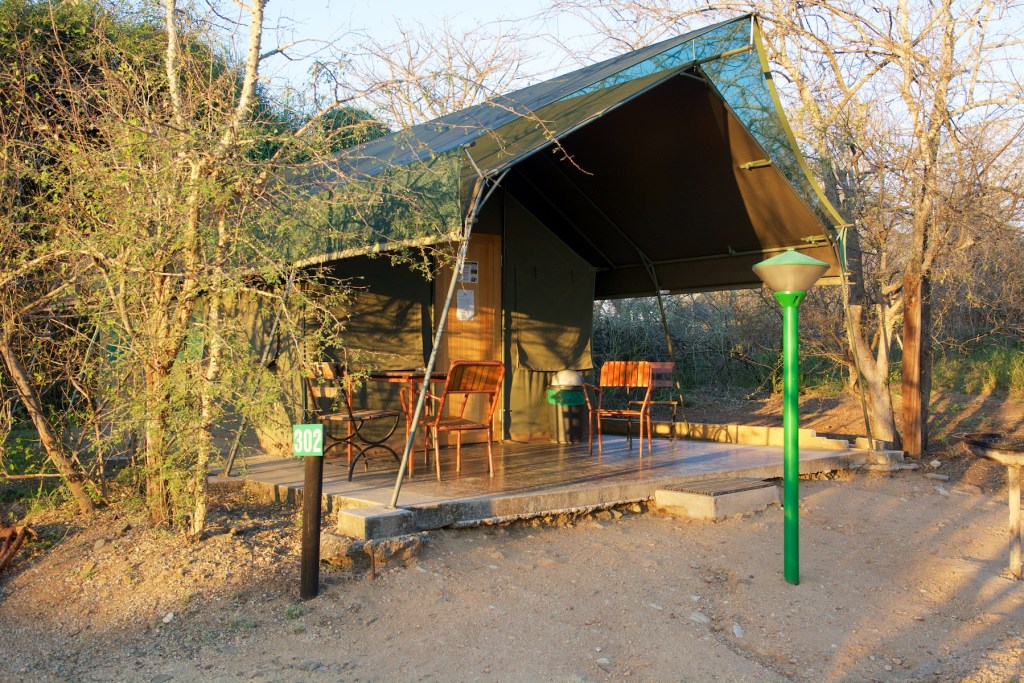Of the three camps we stayed in, the Lower Sabie was our favorite. All the rest camps in Kruger were great but there was something special about this one.

The Lower Sabie is in the southern portion of Kruger, situated on the banks of the Sabie River. Like all the camps, an electrified fence separates the wild from the campers, but it is still easy to look through or above the fence and across to the river. You can hear and see hippos galumping about, crocodiles sunning themselves and various animals coming down to drink. When we arrived we saw a lone elephant munching his way along the river bank. Our family would have been very happy just hanging out in this camp, relaxing and enjoying the view, reading a book, photographing the animals near camp, etc. The stars were magnificent. It was exciting to see a whole different set of constellations, and the milky way was so clear!

The Lower Sabie camp has an excellent restaurant where you can sit outside and enjoy the view. All the restaurants were good in the rest camps. You may not have a lot of choices but the meals are all delicious. BTW, beef is very big in South Africa.

At Sabie we stayed in a one bedroom hut with four single beds, air-conditioning and a refrigerator. There were communal ablutions (bathroom with showers) and an outdoor cooking area with lots of barbecues. They call barbecues “braai” and are very fond of them! Our hut was one of many built around a courtyard of sorts. We ate in the restaurant but it looked like all our neighbors were having a good time cooking and getting to know each other. There were little tables set outside each hut.

The first camp we stayed at upon arrival in Kruger was Berg-en-dal. It was the closest camp to the entrance and I’m glad we chose it. We didn’t need to do any more long drives after the two days it took to get to Kruger! We stayed in a family cottage, complete with kitchen. It was really comfortable and had a lovely little backyard with a braai. We could hear bird song and saw an antelope on the other side of the backyard fence. We heard baboons once too!



Skukuza is the largest camp and administrative headquarters of Kruger. It too is situated on the banks of the Sabie river and has a restaurant with a great view. We would have enjoyed staying longer there as well. Skukuza is so big that they have two restaurants (one was being upgraded and not available), a grocery store, an ATM, a gas station, a 9 hole golf course, a post office, a bank, a laundromat, a doctor (for emergencies only), two swimming pools and a small airport! The camp is more like a small village but it didn’t feel crowded to us; maybe that’s because we were there in early June. We stayed in a semi-permanent safari tent with four comfortable twin beds, a small refrigerator, a large fan and communal (and very clean!) bathrooms. We didn’t take the time to explore the whole camp.



It was nice having a doctor available in Skukuza. Bill and I were worried about a cut on his hand that seemed infected. We were able to see the doctor after about an hour’s wait and he prescribed antibiotics. It seemed that he was mostly seeing employees who needed medical attention, which is why he would only be available to tourists for emergencies.
Making Reservations:
I made reservations and read about the various camps through the South African National Parks website: https://www.sanparks.org/
My reservations worked smoothly and the site seemed very reliable. I used their website for practically all my reservations. You can buy your International Wild Card on this site as well. A conservation fee is required at each camp and buying the wild card ahead of time will save you quite a bit of money. Speaking of money, I am not posting how much we spent on our accommodations because the prices really vary, as does the value of the rand.
I made reservations four months in advance which made it hard to find family accommodations. We took what was available in each camp so our sleeping arrangements really varied. I recommend making reservations six months to a year in advance. You also have to keep in mind that Kruger is 7,523 square miles (19,485 square kilometres) and you must drive slowly at all times. This means you won’t actually cover much ground unless you are staying a long time.

Each camp has a gate that closes by sunset. If you are caught outside the gate you can make a phone call and they will let you in, but you have to pay a huge fine. Most visitors stay in the southern end of Kruger because it is the easiest to get to and has the most animals. As far as getting there – the ways and means are so varied, I’ll just link to a couple websites for you to explore.
https://www.sanparks.org/parks/kruger/get_there/
http://www.krugerpark.co.za/Kruger_Park_Travel_Advisory-travel/getting-to-kruger.html

Lesson Learned: You don’t need to drive on safari the whole time in Kruger, you can enjoy the rest camps too!
You can read about the people and the poverty we witnessed in my next blog.



Fascinating adventure exploring on your own. Looking forward to the next blog.